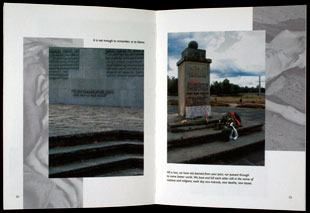Remains 6x 7.8"; 80 pages. Ink jet print on rag paper. Laser print on vellum. Hand bound in black cloth. Ann Lovett: "Remains, a book that continues the exploration of pilgrimage and tourism that I began with Pilgrimage. Its subject is three former concentration camp sites that I photographed in Germany. The trip was in many ways also a pilgrimage for me, as it is for the several million people who visit these sites every year. Perhaps like me they feel the need to be physically present at these places, that some greater understanding, not of what happened, but of the fact of it, is possible through this physical experience of place. This book was an interesting and complex challenge for me, since so much has been written about the camps. I felt that it was important to speak not with an authoritative voice, but with a more visceral response to what I saw, to make something that carried my voice, with its questions and wondering. The book is in three sections, and each one opens with a list of words and a brief history of the camp. I used images from the US Holocaust Memorial Museum Photographic Archive depicting the camps at the time of liberation in the book, and layered them behind my contemporary images. This positioning speaks visually to the process by which individual experiences become obscured as official histories dominate the site. We know the stories and have seen Hollywood's version of the Holocaust, but the real stories are slipping away, sliding under the surface, as survivors dwindle and the metanarratives of history and ‘memorialization’ take over. "The first section is about Bergen-Belsen, which was primarily a holding camp, where prisoners were held for possible exchange for German POW's. When other camps were evacuated by the Germans in anticipation of the arrival of Allied troops, prisoners were moved to Bergen-Belsen, where thousands perished of starvation or disease. The buildings were burned to the ground by British troops who liberated the camp in 1945, to prevent the spread of typhus. It's a Jewish custom to leave a small stone on the headstone of a loved one when visiting a grave. This marks the visit and the importance of the memory of the dead in the lives of the living. At Bergen-Belsen these small stones were everywhere, and this clearly marks it as a site of memory belonging to the living. It is first and foremost a cemetery, where mass grave markers read ‘here lie 5,000 dead’ or ‘here lie 10,000 dead,’ and I wondered how many other bones lay under my feet. I thought about all those muted voices, how little we know about their lives, and how little we've learned from their deaths about making peace in the world. When you visit Bergen-Belsen, you are literally standing above the bones of those who died there, but they are also metaphorically obscured by the beautification of this place and its presentation as a tourist attraction. "The second section is about Mittelbau-Dora, a camp in central Germany. Prisoners were forced to labor here in an elaborate underground tunnel complex, constructing V2 rockets for the German Army. They lived in the tunnels, where conditions were so bad that the average life expectancy was 4 to 6 weeks. The camp was liberated in 1945 by American troops, who bombed closed the tunnel complex and destroyed most of the other buildings. Parts of the tunnel are now open, but a decision was made not to restore it, rather to leave it in the condition in which it was found on reopening. Few other structures remain, except a crematorium used for disposing of the dead, which is one of the few buildings to have been restored. Again I looked for the presence of individuals in this empty place, and the text is a list of prisoners' names that runs continuously behind the pictures, a kind of lament for those who are gone. I also deliberately cropped and placed images into the gutter to express loss and the anonymity of those whose names we do not know. “The third camp in the book is Sachsenhausen, on the outskirts of Berlin, which has a more complex history. Established as a model for other concentration camps, it also became the administrative headquarters for the concentration camp system. Political prisoners were the first to arrive, joined later by those judged racially or biologically inferior. Slave labor, disease, starvation and systematic extermination were common here. Sachsenhausen was liberated by Red Army troops in 1945. After the war it became a Soviet prison camp, with conditions not all that different from those under the Nazi's, until it closed in 1950. The site remained under the political control of the GDR until the reunification of Germany. The manifestation of national and political ideology in how the site is preserved and presented was more apparent to me here than in the other camps. A Soviet monument was erected to honor political prisoners who died here under the Nazi's, and only recently were displays created that document the lives of Jewish and Roma prisoners. Original buildings and furnishings mingle with reconstructions, and the political agendas of control and display are numerous and overlapping. This is a staged authenticity, a postmodern pastiche of histories, ideologies, and constituencies. What should be preserved and what destroyed? What should be remembered and what forgotten? What is the task of interpretation and who should be its author?" |
